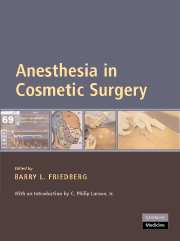Book contents
- Frontmatter
- Contents
- Foreword
- Acknowledgments
- Introduction
- Preface
- List of Contributors
- PART I MINIMALLY INVASIVE ANESTHESIA (MIA)Ⓡ FOR MINIMALLY INVASIVE SURGERY
- 1 Propofol Ketamine with Bispectral Index (BIS) Monitoring
- 2 Preoperative Instructions and Intraoperative Environment
- 3 Level-of-Consciousness Monitoring
- 4 The Dissociative Effect and Preemptive Analgesia
- 5 Special Needs of Cosmetic Dental Patients
- 6 Propofol Ketamine in the UK, Propofol Ketamine Beyond Cosmetic Surgery
- 7 Propofol Ketamine Beyond Cosmetic Surgery: Implications for Military Medicine and Mass-Casualty Anesthesia
- 8 Lidocaine Use and Toxicity in Cosmetic Surgery
- 9 Local Anesthetic Blocks in Head and Neck Surgery
- 10 Local Anesthetics and Surgical Considerations for Body Contouring
- PART II ALTERNATIVE ANESTHESIA APPROACHES IN COSMETIC SURGERY
- PART III OTHER CONSIDERATIONS FOR ANESTHESIA IN COSMETIC SURGERY
- APPENDIX A A Guide to Perioperative Nutrition
- APPENDIX B Reflections on Thirty Years as an Expert Witness
- Index
- References
9 - Local Anesthetic Blocks in Head and Neck Surgery
from PART I - MINIMALLY INVASIVE ANESTHESIA (MIA)Ⓡ FOR MINIMALLY INVASIVE SURGERY
Published online by Cambridge University Press: 22 August 2009
- Frontmatter
- Contents
- Foreword
- Acknowledgments
- Introduction
- Preface
- List of Contributors
- PART I MINIMALLY INVASIVE ANESTHESIA (MIA)Ⓡ FOR MINIMALLY INVASIVE SURGERY
- 1 Propofol Ketamine with Bispectral Index (BIS) Monitoring
- 2 Preoperative Instructions and Intraoperative Environment
- 3 Level-of-Consciousness Monitoring
- 4 The Dissociative Effect and Preemptive Analgesia
- 5 Special Needs of Cosmetic Dental Patients
- 6 Propofol Ketamine in the UK, Propofol Ketamine Beyond Cosmetic Surgery
- 7 Propofol Ketamine Beyond Cosmetic Surgery: Implications for Military Medicine and Mass-Casualty Anesthesia
- 8 Lidocaine Use and Toxicity in Cosmetic Surgery
- 9 Local Anesthetic Blocks in Head and Neck Surgery
- 10 Local Anesthetics and Surgical Considerations for Body Contouring
- PART II ALTERNATIVE ANESTHESIA APPROACHES IN COSMETIC SURGERY
- PART III OTHER CONSIDERATIONS FOR ANESTHESIA IN COSMETIC SURGERY
- APPENDIX A A Guide to Perioperative Nutrition
- APPENDIX B Reflections on Thirty Years as an Expert Witness
- Index
- References
Summary
INTRODUCTION
One of the biggest advances in the last thousand years of medical history has been the discovery of local anesthesia. Prior to this, patients had to endure excruciating pain with procedures taken for granted today. Even the toughest patient cannot imagine having a tooth extracted or an extremity amputated with no anesthesia. Prior to the late 1800s, one could get drunk or literally bite the bullet, neither of which had any effect on pain. An interesting article appeared about a .50 caliber bullet found at the site of the Battle of Ox Hill. The 21st Massachusetts Regiment had fought at a local cornfield with extreme and horrifying injuries. Yet, they had no medical care. The bullet has molar tooth cusp imprints, reportedly from a patient biting during surgery without anesthesia. Figure 9-1 shows an artist's rendition of the horror and panic of such a battlefield amputation, complete with a bullet between the patient's teeth.
Cocaine was the first local anesthetic to be widely used in surgical applications. In the 19th century, it was reported that the Indians of the Peruvian highlands chewed the leaves of the coca leaf (Erythroxylon coca) for its stimulating and exhilatory effects.1–3 It was also observed that these Indians observed numbness in the areas around the lips. In 1859, Albert Niemann, a German chemist, was given credit for being the first to extract the isolate cocaine from the coca shrub in a purified form. When Niemann tasted the substance, his tongue became numb.
- Type
- Chapter
- Information
- Anesthesia in Cosmetic Surgery , pp. 84 - 105Publisher: Cambridge University PressPrint publication year: 2007

